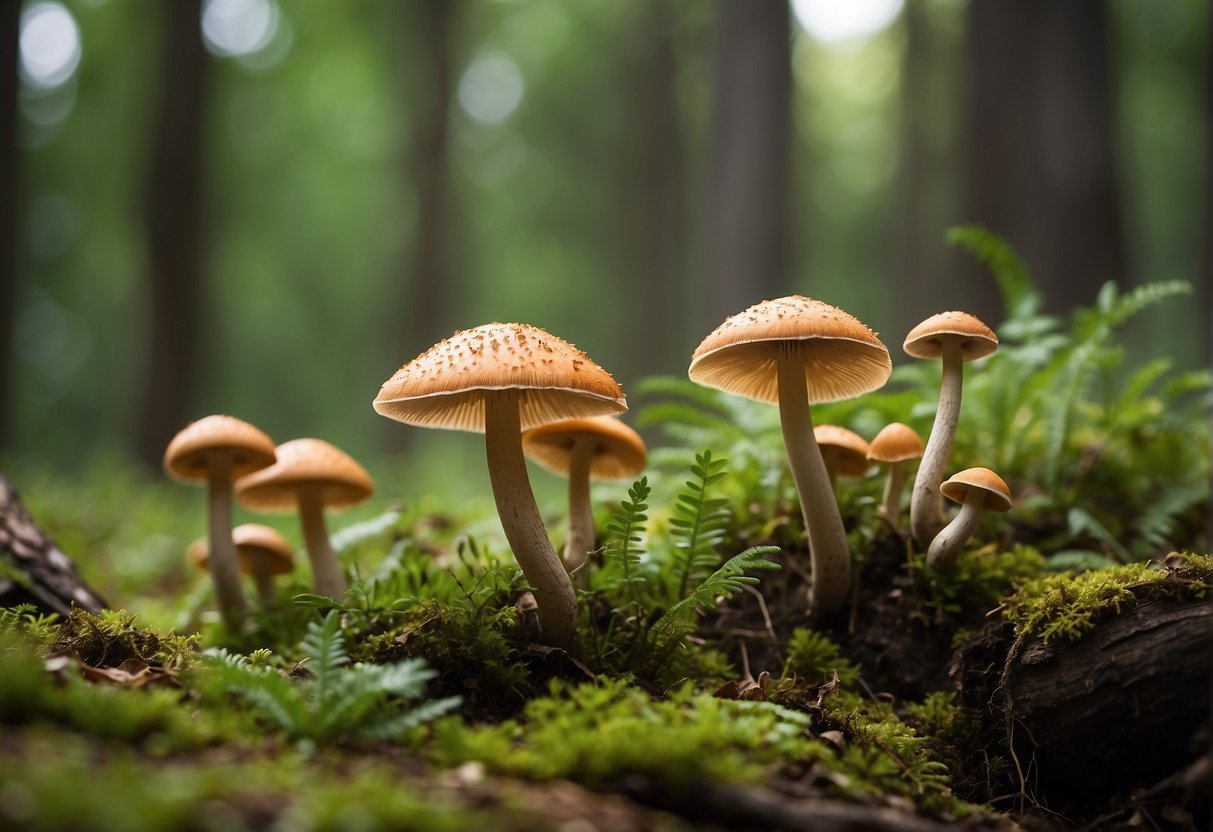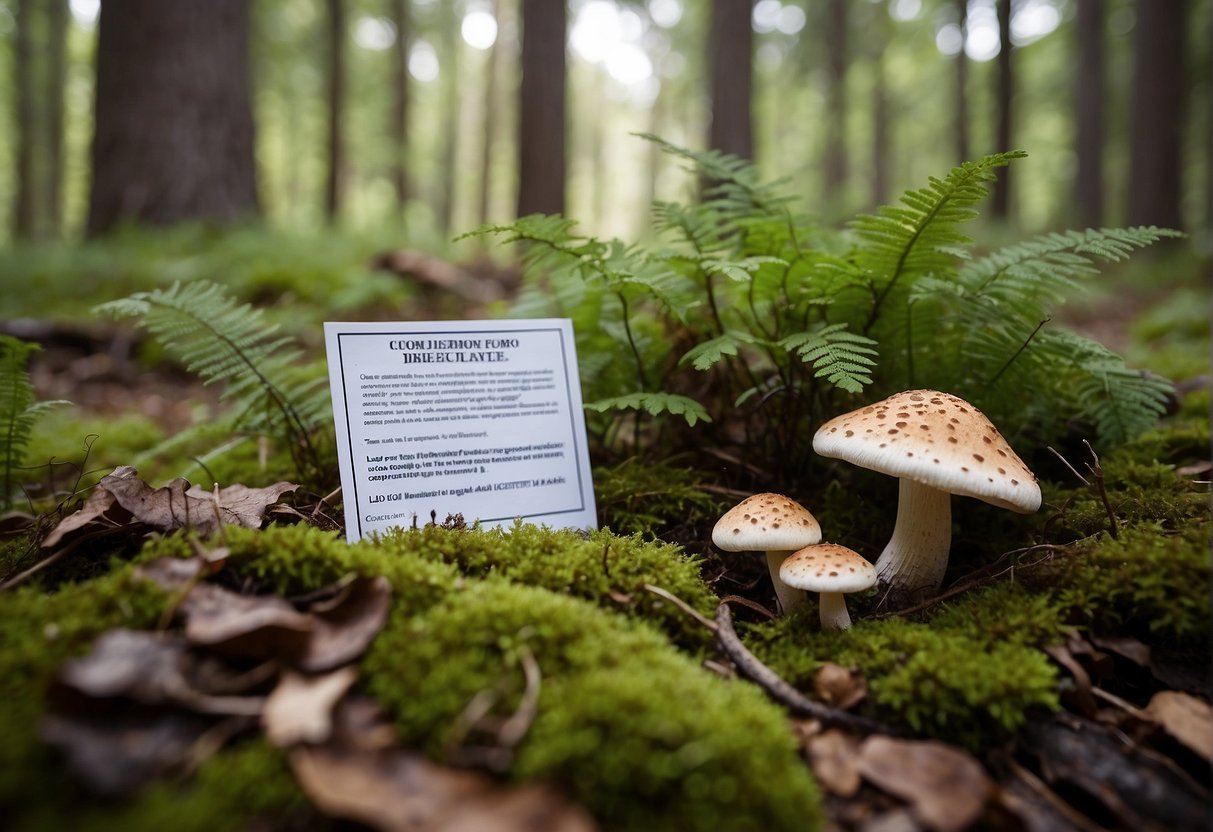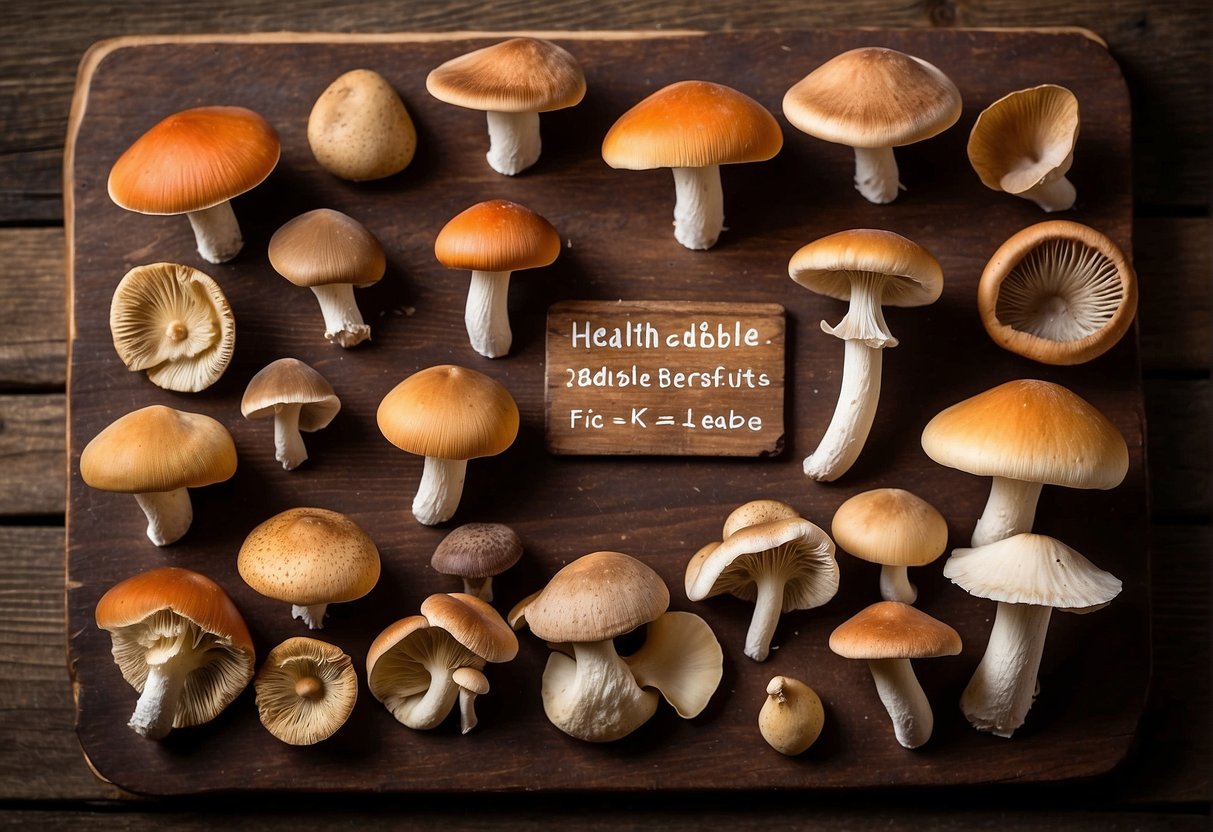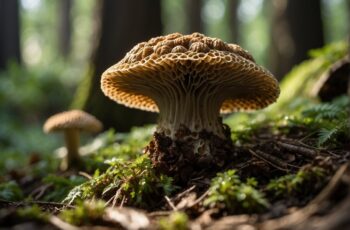Minnesota’s forests and fields are brimming with a diverse collection of mushroom species, many of which are a forager’s delight. Edible Minnesota mushrooms range from easily recognizable varieties to those that require a keen eye and knowledge to safely identify. As you scour the landscape, you’re likely to encounter mushrooms like the highly regarded Morels, found in woods and even backyards, boasting a unique honeycomb appearance.

Whether you’re an experienced mycologist or a curious outdoor enthusiast, foraging for edible mushrooms is both an exciting and rewarding endeavor. Each species you come across has its own distinctive features and flavors, enriching your outdoor adventures and your dining experiences. Pro tip: whenever you go mushroom hunting, ensure you have a reliable field guide or a seasoned forager with you to avoid the risks of misidentifying species that could be harmful.
Key Takeaways
- Mushroom foraging in Minnesota offers a variety of edible species to discover.
- Proper identification of mushrooms is crucial for safe foraging practices.
- Edible mushrooms can provide unique flavors and nutritional benefits.
Identifying Edible Mushrooms in Minnesota
When you’re foraging for mushrooms in the Minnesota wilderness, it’s essential to distinguish safe, edible varieties from their potentially poisonous counterparts. The difference can mean a delightful addition to your meal or a dangerous mistake. A reliable field guide should always accompany you, as accurate identification is crucial.
Morel Mushrooms
Morels are a prized find with a distinctive honeycomb appearance. Look for the yellow morel, with pits and ridges on the cap, typically found during spring in forested areas. Ensure that you’re not picking the false morel, which can be toxic, by checking that the cap attaches directly to the stem with no space in between.
Chanterelles
The golden chanterelle is cherished for its fruity aroma and peppery flavor. These mushrooms have wavy edges and a bright yellow color. They grow on the ground in mossy, hardwood forests. Chanterelles are rarely wormy and have false gills, which appear as wrinkles or forks rather than distinct, blade-like gills.
Oyster Mushrooms
Oyster mushrooms are smooth with broad caps resembling an oyster’s shape. They usually grow on the sides of trees in shelf-like formations and range from white to grey. Oyster mushrooms have a delicate texture and can commonly be found in both wild and urban areas.
Puffballs
Puffballs, or Calvatia genera, are round, white globes that grow on the ground in grassy areas. They are edible when young and the flesh inside is white. Ensure to cut them open; if there are any signs of gills or a distinct cap, avoid consuming them as they could be immature amanita, which is highly poisonous.
Other Notable Species
Among the other edible mushrooms, you might find Maitake or Hen of the Woods, which grows at the base of oak trees in the fall. Honey mushrooms are also edible, but their identification requires more expertise due to their similarity to certain toxic varieties. Always exercise caution and consult up-to-date field guides when foraging for these wild mushrooms.
Foraging Tips and Regulations

When you embark on foraging edible mushrooms in Minnesota, it’s crucial to follow specific best practices for safety and sustainability and to understand the legal considerations to ensure you’re foraging within the confines of the law.
Best Practices
Identification: Before you collect any wild mushrooms, be certain they are indeed the edible kind. Misidentification can lead to foraging poisonous species, which could be harmful or even fatal. Always cross-reference mushrooms with reliable resources and, when in doubt, leave it out.
- Use a field guide or digital resources, such as the Minnesota Mycological Society for correct identification.
- Consider joining a local foraging group to learn from experienced foragers.
Sustainability: Harvest mushrooms responsibly to ensure that the ecosystem remains intact and mushrooms continue to grow for years to come.
- Cut the stem with a knife rather than pulling the mushroom out to protect the mycelium.
- Harvest only what you need and leave some behind to continue the species’ life cycle.
Legal Considerations
Foraging Regulations: Stay updated with Minnesota’s foraging regulations to avoid fines and preserve natural habitats.
- Some areas, like state parks or wildlife management areas, may have specific rules or require permits. Check the Minnesota Department of Natural Resources for the most recent guidelines.
- Be aware that there may be limits on the amount of wild mushrooms you can forage to prevent overharvesting.
Property Laws: Respect private property and public land regulations. If foraging on private land, always ask for permission from the landowner.
Remember, foraging isn’t just a pastime, it’s a privilege that comes with the responsibility of sustaining the natural world around you. As a steward of the environment, your actions can either contribute to the conservation or the depletion of Minnesota’s bountiful wild edible mushrooms.
Health Benefits and Nutritional Information

When you’re out foraging in the Minnesota wilderness, not only are you connecting with nature, but you’re also potentially stocking up on some superb nutritional benefits. Edible mushrooms are not just a tasty addition to your meal; they’re packed with a host of nutrients that can bolster your health.
Mushrooms are low in calories, making them an ideal food if you’re trying to maintain or lose weight. Here’s what you typically get in a one-cup serving of raw mushrooms:
- Calories: Approximately 15-30
- Protein: Roughly 2 grams
- Fiber: Supports digestive health
- Vitamins: Rich in B vitamins, specifically B2 (riboflavin) and B3 (niacin)
- Minerals: A good source of copper, selenium, and potassium
Beyond basic nutrients, mushrooms contain antioxidants like selenium which help combat oxidative stress in your body. Antioxidants play a crucial role in maintaining a healthy immune system and preventing chronic diseases.
| Nutrient | Benefit |
|---|---|
| Protein | Aids in muscle repair and growth |
| Fiber | Keeps your digestive system running smoothly |
| Vitamins | Critical for energy production and brain health |
| Antioxidants | Protects cells from damage |
Mushrooms also have medicinal properties. They have been recognized for their potential to support the immune system, and some studies suggest they may have anti-inflammatory effects. Remember, however, that while edible mushrooms offer numerous health benefits, correct identification is crucial. Explore, enjoy, and nourish your body with the bounties of Minnesota’s forests, while always ensuring your foraged mushrooms are indeed edible and safe.
Preparing and Cooking Mushroom Delicacies
Mushroom foraging in Minnesota provides a bounty of flavorful varieties like chanterelle, chicken of the woods, and hen of the woods. Let’s explore how you can turn these wild gems into delicious meals with the proper techniques and preservation methods.
Recipes and Cooking Techniques
When it comes to chanterelle mushrooms, their delicate peppery flavor makes them ideal for sautés and sauces. Gently clean your chanterelles, pat them dry, and sauté with garlic and onions for a simple yet versatile addition to any dish.
Chicken of the woods mushrooms offer a meaty texture and can act as a meat substitute in vegetarian dishes. They work exceptionally well on the grill, where the high heat accentuates their smoky, savory taste. Slice them into large pieces, brush with olive oil, and grill until each side shows beautiful char marks.
As for hen of the woods mushrooms, their firm texture allows you to roast or sauté them. Their rich taste pairs well with roasted meats but can also stand alone as a hearty versatile ingredient in a stir-fry or as a topping for a crisp, rustic pizza.
- Grilled Chicken of the Woods:
- Brush large slices with olive oil.
- Grill over medium-high heat until charred.
- Season with salt and a touch of lemon juice.
Remember, mushrooms are like sponges, so avoid soaking them in water; a quick rinse or brushing off the dirt maintains their inherent flavors.
Preservation Methods
To enjoy your mushroom haul year-round, consider preserving methods like drying or pickling. Dried mushrooms retain their flavorful character and can be rehydrated for use in soups and stews. Lay them out on a wire rack in a well-ventilated room or use a dehydrator to dry them thoroughly.
Pickling is another suitable method, especially for chanterelles, which can be preserved in a vinegar-based brine with spices. This technique not only extends their shelf life but also infuses the mushrooms with a tangy flavor, ideal for salads and antipasto platters.
- Drying Mushrooms:
- Clean and slice mushrooms.
- Place on wire racks or in a dehydrator at 110-115°F.
- Store in an airtight container once completely dry.
Embrace these preservation techniques to ensure that your foraged mushrooms remain an integral part of your culinary adventures throughout the seasons.


